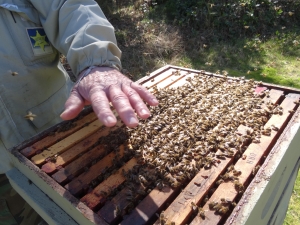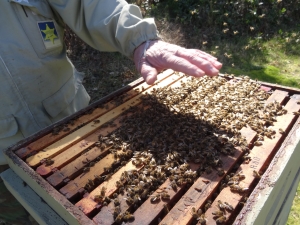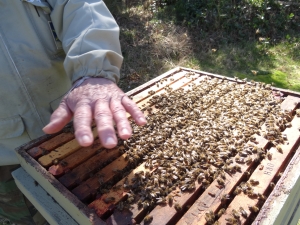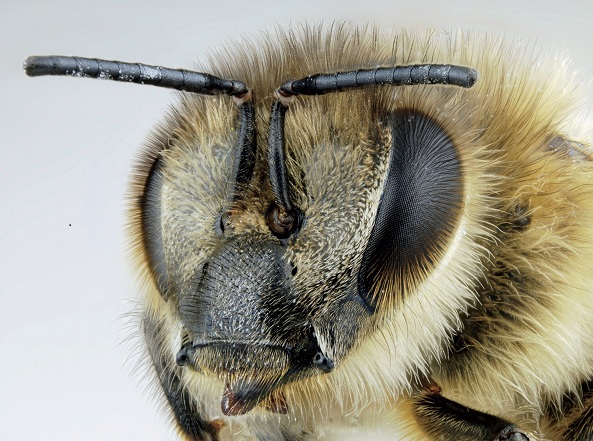http://www.forksforum.com/news/article.exm/2013-10-24_clallam_bay_buzzes_over_downed_bee_tree
Clallam Bay buzzes over downed bee tree
Published on Thu, Oct 24, 2013
By Donna Barr, West End North Correspondent

When Sheriff’s Deputy Joe Pursley flashed his lights and pulled over behind a backhoe truck parked on the verge on Frontier Street in Clallam Bay, Thursday, Oct. 17, he thought he was only going to warn about a road blockage issue.
Instead, he found himself dealing with two people facing off over the same downed bee tree.
Dan Harvey, who had begun the careful rescue of the bees on Wednesday, found that Rafael Ojeda had undone his work and chain-sawed the nest tree open, roughly pulling out the combs and dumping them into a manufactured hive body.
Harvey, who raises queen bees bred from the Olympic Peninsula strain of feral bee in his bee yard at Olympic Wilderness Apiary, was alerted on Tuesday, Oct. 15, about the nest by Lyle Sage, who had clearcut the roadside maple grove, and discovered the bees inside a hollow hemlock.
“I took him a gallon of honey,” said Harvey. “He was just tickled pink.”
Harvey was eager to find these bees, especially their queen, for addition to the gene base of his own strains of the singular local bee.
On Wednesday, Harvey had found the remainder of the hemlock log was too big to move without heavy equipment.
The bee cavity was full of rotted mulch, but Harvey knew that 80 percent of feral bee trees locate their entrance above their brood nest.
He didn’t have to dig far into the top end of the log before he could see the comb. He sprayed the area with liquid smoke to quiet the bees, as well as the nest entrance, located in the badly healed branch cavity that had let in the original rot.
Harvey was assisted by Gus Gustafson, who has split bee trees in the past. Gustafson sawed through both ends of the log under Harvey’s guidance, first carefully poking with the chainsaw, probing for honey, to make sure he wasn’t punching into the nest cavity.
Once the chainsaw came out dry, the saw whipped off the bottom of the log.
The resulting raw hive might have been small enough to roll, but was still too big to lift into Harvey’s truck. Gustafson wondered if they should just saw slats off the thick outer wood around the cavity, to lighten the load.
(This correspondent said she’d just thought of that, but was afraid it was too dumb to mention.)
“No, this is what we call field expediency!” grinned Harvey, adding he’d rather not, because it wouldn’t look good in his bee yard.
To protect the bees and their attractive honey from bears and raccoons, Harvey nailed a small square of plywood over the top, and screened off the base and nest entrance. Knowing the bees, already stressed by the felling of their tree, couldn’t last many days trapped inside their nest, he quickly left to borrow a backhoe.
He couldn’t return until the next Thursday morning, when Pursley found the two men exchanging words.
Ojeda said that someone, whose name he does not know, told him about the tree and warned him that residents would come spray and kill the bees if they discovered them. Ojeda arrived, probably soon after Harvey had left. He tore off the plywood and screens, saying he’d taken the latter with him.
Thursday, Harvey discovered the condition of the nest.
Harvey shook his head, saying the bees were badly weakened and probably couldn’t survive the winter, even if he added his own bees to them.
Ojeda claimed the queen was in the hive box, but Harvey couldn’t find her.
In the end, Harvey took Ojeda’s box, to transport what remained of the colony to his bee yard. He hoped the queen was in the box and not hiding in what remained of the shattered nest.
Pursley said before calling in the incident, “That’s the first time I’ve ever had a bee call, that’s for sure.”
On Friday, Harvey found the queen, so he has a chance to broaden the genetic base of his stock and contribute to the health of all the feral survivor bees. It’s one more step in maintaining a non-native domestic animal that actually contributes to the health of the wild and has become a special part of the local environment.
The wild bees of the peninsula are descended from domestic Caucasian strains brought to the area by homesteaders in the 19th century.
Locally nicknamed “pioneer bees,” and designated by Harvey as “survivor bees,” they are different in appearance from other, more-recently imported domestic bees, carrying a wisp of fluff on their abdomens that makes them appear gray, earning them their other nickname, “gray bees.” They have evolved to survive the wet winters and short summers of the peninsula.
However, they aren’t immune to European foul-brood, a disease that turns the larvae in the combs into so much protein goo. Harvey said he’d brought home feral populations before and the young collapsed under the disease attack.
Hives also are attacked and weakened by the Varroa mite, that have been theorized as being one of several causes of colony-collapse disorder threatening domestic bees.
Harvey has been working with university programs to breed foul-brood-resistant Russian and Varroa Sensitive Hygiene (VHS) strains into the local bees. The added strains are both known for their very hygienic brood-comb behavior, keeping the cells so clean the infection and mites have less chance to start or spread.
Resistant drones (males) have been introduced into the wild during the swarming season to improve the wild-living strains.
When Harvey took the bees home with him, that doesn’t mean it was the end of feral bees in the area. Pointing to a rounded wax stub at the exposed top of the nest, said, “There’s a queen cup, so they’ve swarmed out before.”
The colony had fed a larvae with royal jelly, making her into a queen in a larger, cone-like cell.
When she matured and mated, the younger generation of bees would have followed her into the surrounding woods. Perhaps the flowered bush will still hum with bees next summer.
Given opportunity, the bees can colonize a building very quickly.
Dona Lynn Olson, of Olson’s Resort, was aware of the local strain’s existence.
Several years ago she displayed an entire disused shed full of the bees on her property in Sekiu. The only problem they might cause would result from honey stored in the space between the ceiling and the roof; busy bees could have pumped 3,500 gallons into that space in a fast blackberry-blossom summer.
Before it was all over, Jane Hielman, of the Sunsets West Co-Op added a bee story of her own.
She’d been on a plane that had to land in Darwin, Australia, because someone on board a two-story 747 had smoked their beehive and it had set off the carbon dioxide fire-represent system in the plane.
Harvey and the correspondent, by this time having had too much fun on the bee project, wondered how one transported bees in the pressurized body of a commercial flight. Did they have to buy the bees a seat? Did they all sit in row “B”?



 The last time we checked with Seattle mayor-turned-beekeeper Wes Uhlman, his two hives on Queen Anne Hill were doing fine. It was three years ago, and all across farm country a mysterious syndrome called colony collapse disorder was making bees abandon their doomed hives, threatening an agricultural catastrophe. But CCD hadn’t slammed Uhlman or his fellow local backyard beekeepers as severely as others. That made him suspect that Big Ag pesticides—not a big factor on Queen Anne—were the cause.
The last time we checked with Seattle mayor-turned-beekeeper Wes Uhlman, his two hives on Queen Anne Hill were doing fine. It was three years ago, and all across farm country a mysterious syndrome called colony collapse disorder was making bees abandon their doomed hives, threatening an agricultural catastrophe. But CCD hadn’t slammed Uhlman or his fellow local backyard beekeepers as severely as others. That made him suspect that Big Ag pesticides—not a big factor on Queen Anne—were the cause.